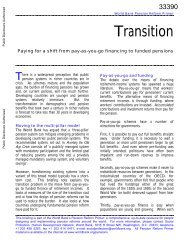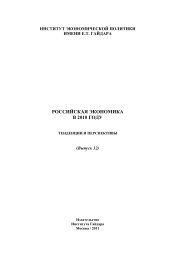Financial Sector Development in Africa: Opportunities ... - World Bank
Financial Sector Development in Africa: Opportunities ... - World Bank
Financial Sector Development in Africa: Opportunities ... - World Bank
You also want an ePaper? Increase the reach of your titles
YUMPU automatically turns print PDFs into web optimized ePapers that Google loves.
94 Coates and Hofmeister<br />
farm <strong>in</strong>puts such as credit or extension services to the supplier <strong>in</strong> return<br />
for the guaranteed supply of agricultural products—sometimes show<br />
these features. Such schemes also offer the producers economies of scale<br />
<strong>in</strong> bulk <strong>in</strong>put purchas<strong>in</strong>g and logistics, together with market<strong>in</strong>g power.<br />
Buyer and supplier f<strong>in</strong>ance <strong>in</strong> practice. The bank must first identify suitable<br />
<strong>in</strong>termediary firms—either <strong>in</strong>put suppliers or produce buyers. These<br />
firms would ideally be those with whom they already have solid bank<strong>in</strong>g<br />
relationships. For the purposes of reach<strong>in</strong>g producers directly, the <strong>in</strong>termediary<br />
firm would have direct trad<strong>in</strong>g relationships with producers and/<br />
or producer groups; however, for the purposes of value cha<strong>in</strong> f<strong>in</strong>ance this<br />
is not necessarily the case (box 3.2).<br />
The bank needs to agree on an appropriate credit l<strong>in</strong>e and terms and<br />
conditions <strong>in</strong> l<strong>in</strong>e with the market risk profile and competitive conditions.<br />
It needs to develop a simple and streaml<strong>in</strong>ed credit process for the <strong>in</strong>termediary<br />
firm, ideally with a basic application form that the <strong>in</strong>termediary<br />
can use to “score” the proposed customer <strong>in</strong> l<strong>in</strong>e with the agreed credit<br />
policy. For example, criteria could <strong>in</strong>clude a specified m<strong>in</strong>imum length of<br />
time that the producer/producer association has had a relationship with<br />
Box 3.2<br />
Case Study: <strong>Development</strong> of Supplier F<strong>in</strong>ance <strong>in</strong> Ghana<br />
A bank <strong>in</strong> Ghana had a large local supermarket as a customer. The supermarket<br />
was keen to expand its sales of horticultural produce from local producer groups,<br />
but supplies were unreliable and limited. It wanted to improve its supply cha<strong>in</strong> by<br />
mak<strong>in</strong>g formal arrangements with producer associations to supply an agreed<br />
quantity and quality of produce and price <strong>in</strong> return for help<strong>in</strong>g pref<strong>in</strong>ance production.<br />
Rather than rely<strong>in</strong>g entirely on its own balance sheet, it had approached<br />
the bank with a view to help<strong>in</strong>g with a credit l<strong>in</strong>e of its own.<br />
Although the bank would have been a reluctant lender directly to small agricultural<br />
producers, it was comfortable <strong>in</strong> bank<strong>in</strong>g a larger supermarket customer<br />
with formal management and account<strong>in</strong>g structures. The bank was will<strong>in</strong>g to<br />
<strong>in</strong>crease its work<strong>in</strong>g capital credit l<strong>in</strong>es to the bank on the back of a clear explanation<br />
of the trad<strong>in</strong>g model. This expansion of work<strong>in</strong>g capital for the supermarket<br />
was used to help <strong>in</strong>crease pref<strong>in</strong>ance production and to improve the work<strong>in</strong>g<br />
capital arrangements of its key horticultural suppliers.<br />
Source: Coates et al. 2011b.







